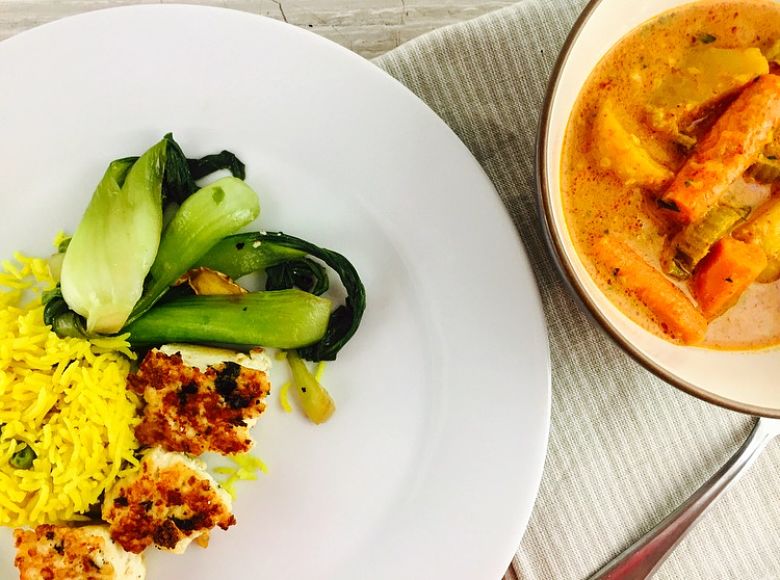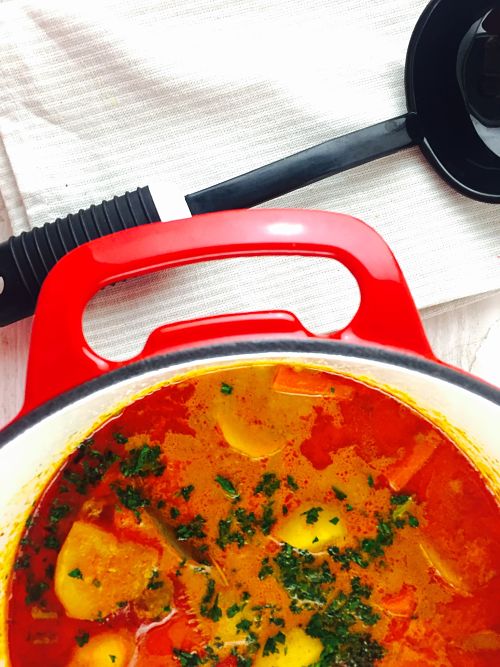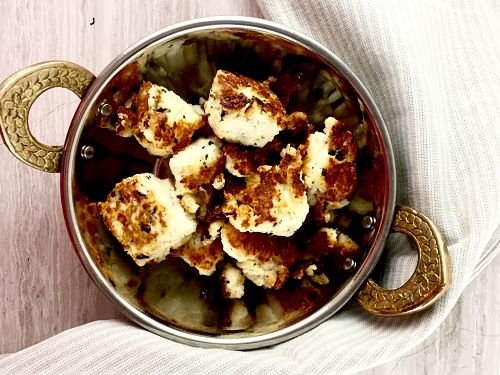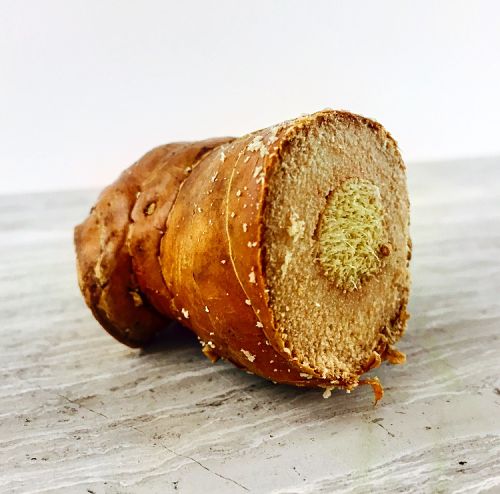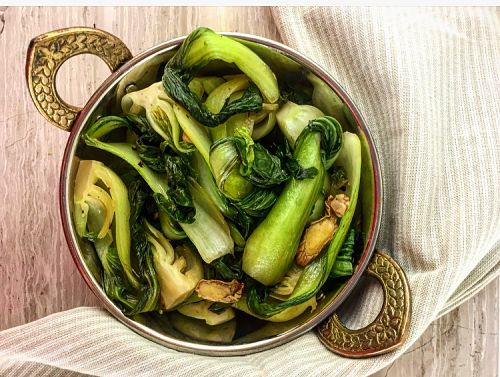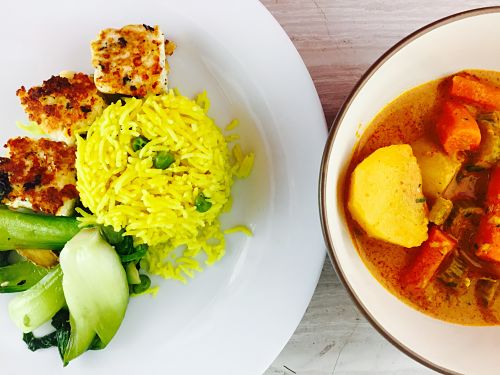HI!
Did you all have a fabulous Thanksgiving weekend? Did you gorge on a bunch of food?
I ate too much.
Justin and I went to my parent’s house in Las Vegas. We are slightly less traditional and went to Flemming’s Steakhouse.
IT WAS AMAZING.
The steak was super tender and they served us these delicious bacon devilled eggs and lots of butter and bread prior to our entrees. You guys. That butter. OMG. Could have eaten a tub of it. They had two kinds; roasted tomato and a chardonnay infused feta. [ picks jaw off of floor ]…
So, today I have a surprise for you!
Our guest writer Andrew Lee is back; but this time we are doing a co-piloted, Indo-Chinese (Indian- Indonesian – Chinese) cuisine, Meatless Monday post!
Andrew has a background of Indonesian-Chinese and I have a background in Indian.
Some of the best Chinese food I have ever had was in India, so I am really excited for Andrew and I to combine our flavor profiles into this stellar dish!
After a few brainstorming sessions, or as Andrew would say, “spitballing,” we came up with a harmanoized fusion dish.
We decided on a crispy chili-paneer (Indian), with red curry (Chinese) and fragrant, yellow, turmeric and coconut milk rice (Indonesian – Indian combination).
Are you salivating yet?
Let me break down a little background info for you.
“Indian Chinese cuisine is the adaptation of Chinese seasoning and cooking techniques to Indian tastes through a larger offering of vegetarian dishes. The Indian Chinese cuisine is said to have been developed by the small Chinese community that has lived in Kolkata (formerly Calcutta) for over a century. Today, Chinese food is an integral part of the Indian culinary scene.
Foods are flavored with spices such as cumin, coriander seeds, and turmeric, which are traditionally not associated with much of Chinese cuisine. Hot chili, ginger, garlic, sesame seeds, dry red chilies, black pepper corns and yogurt are also frequently used in dishes. This makes Indian Chinese food similar in taste to many ethnic dishes in Southeast Asian countries such as Singapore and Malaysia, which have strong Chinese and Indian cultural influences.
Non-staple dishes are served with generous helpings of gravy, although they can also be ordered dry or without gravy.”
Usually, in India, Chili Paneer comes served both ways. It is all about preference.
“Culinary styles often seen in Indian Chinese fare include “Chili” (implying batter-fried items cooked with pieces of chili pepper), “Manchurian” (implying a sweet and salty brown sauce), and “Schezwan” (implying a spicy red sauce). These correspond loosely, if at all, with authentic Chinese food preparation.”
In both cultures cheese is not as prominent as in Western Cultures.
In India, paneer is a staple in the North and is made from cow’s milk. Throughout the country, the cow is considered sacred. Although the cow is not used for its meat it is used for milk, butter, ghee and curds.
The Indian diet mainly consists of fresh vegetables, lentils, rice and abundance of spices. Paneer is the only cheese used, as many variations of cheese to do not exist there and the paneer cheese is often made at home, from scratch.
Andrew..
“Chinese food doesn’t usually have cheese in it. It’s rare that someone isn’t a little bit lactose intolerant for some dishes that have cheese. I suddenly came to terms that the really good buffalo chicken dip that my friends make, I can only have in very moderate portions. The same things go for too much cheesy pizza or mac & cheese. Whenever I encounter certain items ordered from your omnipresent American/Chinese chain restaurants like cream cheese wontons or crab rangoon, it makes me furrow my brow. Cream cheese in a crispy wonton wrapper has such an odd flavor profile. It seems very weird to me.
I am really excited to see how we can bring together a very neutral cheese like paneer into a curry that is based on many of the diverse ingredients my mother learned from her mother when making curry growing up in Indonesia and China. I can totally see paneer be used like tofu which will make this so delicious.”
For us, this dish was all about colors.
We wanted something vibrant and bold so we decided on a red Chinese curry base. Don’t kill us, but we used a can. Andrew brought over a Red Curry Paste by Maesri. The paste has a combination of chili pepper, garlic, shallot, salt, lemongrass, kaffir lime, galangal, and Indian spices, coriander, cumin and cardamom.
Andrew..
“The base of the curry was Chinese traditional with fresh shallot, garlic and ginger sweating in veggie oil. Then came the red curry paste. We mixed in some fresh serranoes to build the heat, Indian style, and mixed in fresh lemongrass a little water and coconut milk.”
We added carrots and potatoes into the curry, making it heartier.
The paneer was made from scratch, but you can certainly buy pre-made paneer from your local specialty store. Like Andrew said earlier, paneer is very neutral and does not have that ooeygoey texture of regular cheese. It does not melt, and stays firm.
The paneer is cut into bite sized squares and fried in vegetable oil. The crunch of the paneer brings texture to the curry, offsetting the softened carrots and potatoes.
We wanted a fresh aspect to the dish in addition to the veggies that we added to the curry, so we sautéed bok choy and garlic in the wok.
The baby bok choy brought a beautiful, bright green to the dish.
This dish is all about the colors.
Finally, as no Asian dish can be complete without it, rice! We mixed in a little turmeric, peas and coconut milk, brought it to a boil and let the rice steam.
Again, with the colors!
Yellow rice, green baby bok choy, a soft orange curry.
Color, Color!
This dish was too pretty to eat but somehow, we managed.
- 1 small can red curry paste
- 1 can coconut milk
- 6 cloves of garlic, minced
- 4 small carrots, chopped
- 3 medium sized potatoes, chopped into small pieces
- 2 shallots, minced
- 2 Serrano chilies, minced
- 1-2 Bay leaves
- 1 cup of celery, diced
- 1 piece on lemongrass, cut into 2 inch segments
- 1 piece of ginger, finely sliced into 4 dime sized pieces
- Salt to taste
- 2-3 tablespoons of ground galangal
- 1 tsp ground turmeric
- 1 tsp ground cumin-coriander
- Oil
- water
- 1 cup basmati rice
- ½ cup frozen peas
- 1 ½ cans coconut milk.
- 2 bay leaves
- 1 ½ teaspoons turmeric
- 1 clove
- Salt to taste
- 4-5 baby bok choy florets, ends cut and quartered
- 4 cloves of garlic, minced
- 1 piece of ginger, finely sliced into 2 dime sized pieces
- Oyster sauce to taste
- Oil
- water
- Fresh paneer; homemade or store bought. For fresh read above for the link.
- Add enough vegetable oil to lightly coat the bottom of a Dutch oven or stewing pot and heat. Add minced shallots, garlic, and pieces of finely sliced ginger to the oil and brown. Add chilies and ground galangal to the mixture. Allow to heat for several minutes over medium.
- Add red curry paste, turmeric, and cumin-coriander into the base. The base will reduce after 2-3 minutes. Add a cup of water to the pot. Mix and simmer for 10 minutes.
- Add lemongrass pieces and bay leaves to the base. Continue to simmer for 5 minutes.
- Stir in coconut milk, celery, and carrots. Allow to simmer for 20 minutes.
- Add in potatoes.
- Continue to simmer for 10 minutes or until potatoes are cooked.
- While the curry is simmering, bring rice, peas, coconut milk, bay leaves, turmeric and salt to a boil.
- Once boiling reduce heat to a simmer and let simmer for 15 minutes.
- Remove off heat and let sit with the lid closed for 10 minutes.
- Fluff with a fork and serve.
- While the curry is simmering. Add a tablespoon of oil into a wok or sauté pan until heated.
- Add ginger and garlic, let brown for about 1 minute.
- Add in baby bok choy, moving it around the pan to let fry.
- Add a teaspoon of salt and let baby bok choy reduce.
- Once reduced add ¼ cup water and 1 tablespoon of oyster sauce.
- Continue to cook for 5-6 minutes or until tender.
- In a frying pan add 2 tablespoons of oil. Cut paneer into 1 ½ - 2-inch-thick pieces.
- Let fry, flipping until all the sides are golden brown and crunchy.
- If you do not want the curry to be too spicy, eliminate the jalapenos and bump up the coconut milk!

